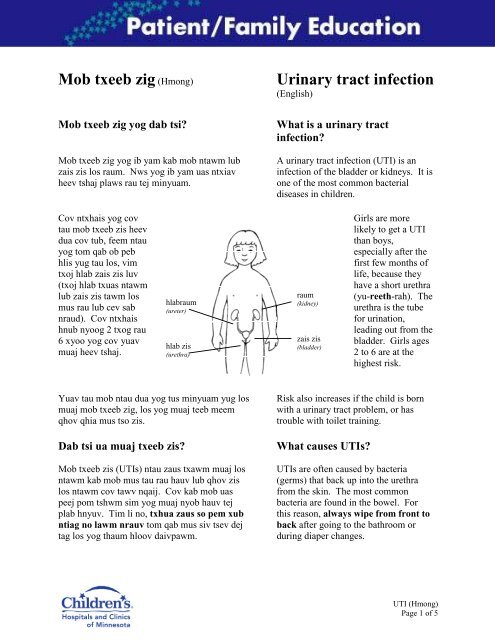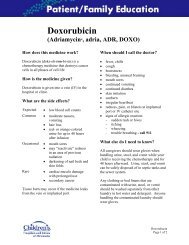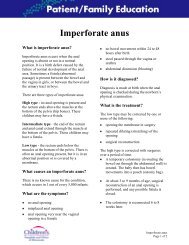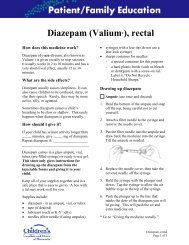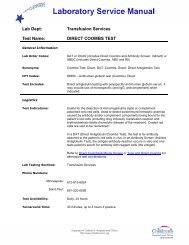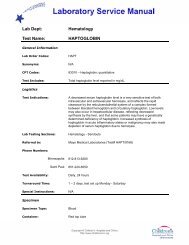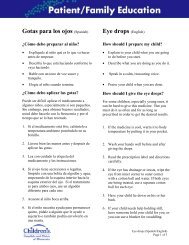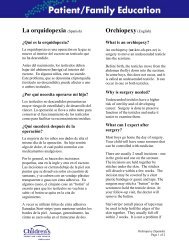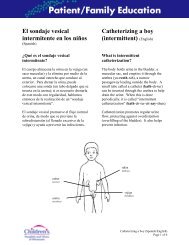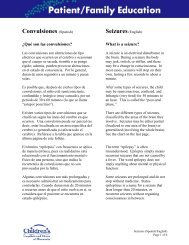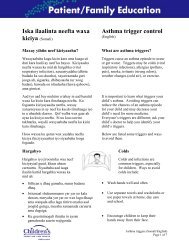Urinary Tract Infection (Hmong) - Children's Hospitals and Clinics of ...
Urinary Tract Infection (Hmong) - Children's Hospitals and Clinics of ...
Urinary Tract Infection (Hmong) - Children's Hospitals and Clinics of ...
You also want an ePaper? Increase the reach of your titles
YUMPU automatically turns print PDFs into web optimized ePapers that Google loves.
Mob txeeb zig (<strong>Hmong</strong>)<br />
Mob txeeb zig yog dab tsi?<br />
Mob txeeb zig yog ib yam kab mob ntawm lub<br />
zais zis los raum. Nws yog ib yam uas ntxiav<br />
heev tshaj plaws rau tej minyuam.<br />
Cov ntxhais yog cov<br />
tau mob txeeb zis heev<br />
dua cov tub, feem ntau<br />
yog tom qab ob peb<br />
hlis yug tau los, vim<br />
txoj hlab zais zis luv<br />
(txoj hlab txuas ntawm<br />
lub zais zis tawm los<br />
mus rau lub cev sab<br />
nraud). Cov ntxhais<br />
hnub nyoog 2 txog rau<br />
6 xyoo yog cov yuav<br />
muaj heev tshaj.<br />
hlabraum<br />
(ureter)<br />
hlab zis<br />
(urethra)<br />
Yuav tau mob ntau dua yog tus minyuam yug los<br />
muaj mob txeeb zig, los yog muaj teeb meem<br />
qhov qhia mus tso zis.<br />
Dab tsi ua muaj txeeb zis?<br />
Mob txeeb zis (UTIs) ntau zaus txawm muaj los<br />
ntawm kab mob mus tau rau hauv lub qhov zis<br />
los ntawm cov tawv nqaij. Cov kab mob uas<br />
peej pom tshwm sim yog muaj nyob hauv tej<br />
plab hnyuv. Tim li no, txhua zaus so pem xub<br />
ntiag no lawm nrauv tom qab mus siv tsev dej<br />
tag los yog thaum hloov daivpawm.<br />
<strong>Urinary</strong> tract infection<br />
(English)<br />
What is a urinary tract<br />
infection?<br />
A urinary tract infection (UTI) is an<br />
infection <strong>of</strong> the bladder or kidneys. It is<br />
one <strong>of</strong> the most common bacterial<br />
diseases in children.<br />
raum<br />
(kidney)<br />
zais zis<br />
(bladder)<br />
Girls are more<br />
likely to get a UTI<br />
than boys,<br />
especially after the<br />
first few months <strong>of</strong><br />
life, because they<br />
have a short urethra<br />
(yu-reeth-rah). The<br />
urethra is the tube<br />
for urination,<br />
leading out from the<br />
bladder. Girls ages<br />
2 to 6 are at the<br />
highest risk.<br />
Risk also increases if the child is born<br />
with a urinary tract problem, or has<br />
trouble with toilet training.<br />
What causes UTIs?<br />
UTIs are <strong>of</strong>ten caused by bacteria<br />
(germs) that back up into the urethra<br />
from the skin. The most common<br />
bacteria are found in the bowel. For<br />
this reason, always wipe from front to<br />
back after going to the bathroom or<br />
during diaper changes.<br />
UTI (<strong>Hmong</strong>)<br />
Page 1 <strong>of</strong> 5
Tej cim mob txeeb zis zoo li cas?<br />
Tej cim mob txeeb zis zoo sib txawv raws hnub<br />
nyoog. Ib txwm yuav muaj ua npaws thiab tso<br />
zis nyuab, tab sis, nyob rau minyuam yaus qhov<br />
mob yuav tsis tshua paub meej. Cov nram qab<br />
no yog qee yam koj yuav tau saib xyuas rau:<br />
Minyuam mos<br />
• ua npaws/kub cev<br />
• tsis xis nyob<br />
• mob plab tsawv yos (quaj thiab ncab kav<br />
ceg)<br />
• teeb meem pub rau noj<br />
• ntuav<br />
• zawv plab<br />
• pob tw ntse<br />
• tso zis tsis so los yog ntub diaper tas li<br />
• cov zis txawv xim los yog tsw ntxhiab<br />
Cov ob peb xyoos thiab minyuam yaus<br />
• ua npaws/kub cev<br />
• quaj los yog ncab thaum tso zis<br />
• tsis kam tso zis<br />
• tsis tso zis thiab rov qab pib tso zis nyuab<br />
• cov zis ua kua ntxhai los yog muaj ntxhiab<br />
tsw phem heev<br />
• ib tug minyuam uas ib txwm qhuav qhawv<br />
kuj yuav pib tau rov dim zis yuam kev ntub<br />
ris<br />
Minyuam loj, cov hluas, thiab cov laus<br />
• ua npaws/kub cev<br />
• tso zis mob heev cuag kub nyhiab<br />
• dim zis tam sid los yog ib sij dim zis<br />
• mob yav duav hauv qab, tom ib sab, ntawm<br />
plab, ncej puab, los puab tais<br />
• zis nro los yog tsw ntxhiab.<br />
What are the signs <strong>of</strong> a UTI?<br />
Signs <strong>of</strong> a UTI vary for different ages.<br />
Fever <strong>and</strong> trouble with urinating are<br />
common; however, in young children<br />
the signs may be unclear. Watch for<br />
these possible signs:<br />
Infants<br />
• fever<br />
• irritability<br />
• colicky or cramping signs (crying<br />
<strong>and</strong> flexing legs)<br />
• feeding problems<br />
• vomiting<br />
• diarrhea<br />
• diaper rash<br />
• dribbling <strong>of</strong> urine or constantly wet<br />
diaper<br />
• urine has a strange color or smell<br />
Toddlers <strong>and</strong> young children<br />
• fever<br />
• crying or straining with urination<br />
• refusing to urinate<br />
• stopping urination <strong>and</strong> having<br />
trouble starting again<br />
• urine is cloudy or has a bad smell<br />
• a child who is usually dry may start<br />
having wetting accidents<br />
Older children, teens, <strong>and</strong> adults<br />
• fever<br />
• pain or burning during urination<br />
• urgent or frequent urination<br />
• pain in the lower back, flank (sides<br />
<strong>of</strong> the low back), abdomen (belly),<br />
thighs, or groin<br />
• urine is cloudy or has a bad smell<br />
UTI (<strong>Hmong</strong>)<br />
Page 2 <strong>of</strong> 5
Kuv yuav tu kuv tus minyuam li cas?<br />
Teem caij mus kuaj zis xyua kab mob. Yog kuaj<br />
mauj lawm, yuav xaj ib qho tshuaj tua kab mob<br />
rau.<br />
Kho ib qho mob txeeb zig nrog ib hom tshuaj<br />
tua kab mob uas yog kws khomob xaj. Yog<br />
tsis kho, qhov mob yuav ploj mus tab sis cov kab<br />
mob yuav nyob. Cov kab mob kuj yuav tws tau<br />
raws ob txoj hlab raum mus rau hauv ob lub<br />
raum. Ib qho raum tau kab mob kuj yuav ua tau<br />
rau lub raum puas mus li. Muab cov tshuaj tua<br />
kab mob rau kom ntev raws li kws khomob<br />
qhia koj. Lub sij hawm no, teem ib lub caij 3<br />
hnub tom qab thaum muab cov tshuaj tua kab<br />
mob tag raws li sij hawm hais tseg. Koj tus<br />
minyuam yuav tsum tau rov mus kuaj zis dua<br />
xyuas kom meej tias cov kab mob ploj tag lawm<br />
tiag.<br />
Yee duab X-rays ob lub raum thiab zais zis kuj<br />
yuav tsum tau ua coj los mus xyuas sab hauv seb<br />
yog teeb meem ab tsis thiaj ua mob txeeb zig.<br />
Tham nrog koj tus kws khomob. Kuj teem tau<br />
caij xoo fais fab rau lub caij yuav rov qab tuaj<br />
kuaj xyua dau los yog lwm lub sij hawm.<br />
Cov kev tu noj qab haus huv nram qab no yuav<br />
pab kho thiab kuj yuav tiv thaiv tau ib qho mob<br />
txeeb zis thaib:<br />
• Txhawb kom haus tej yam ua kua kom ntau.<br />
Txwv tej yam muaj kasfes (dej qabzib cola,<br />
chovkomlem, kasfes, this), rau qhov tej no ua<br />
tau kom mob txeeb zig heev zog tuaj.<br />
• Tom qab siv tsev dej tag thiab da dej los yog<br />
da dej tshuag saum tob hau los, so txhua<br />
txhua zaus, thiab so ntawm sub ntiag rov<br />
sab nraum thiaj txuag tau kom cov tej kab<br />
mob hauv tej plab hnyuv/quav txob los ze<br />
ntawm lub qhov zis. Zam qhov uas peej<br />
txhuam mus txhuam los. Qhia koj tus<br />
minyuam seb yuav so li cas thiaj yog.<br />
How should I care for my child?<br />
Make an appointment for a urine test to<br />
check for germs. If the test is positive,<br />
an antibiotic will be prescribed.<br />
Treat a UTI with a prescribed<br />
antibiotic. If it is not treated, the<br />
symptoms may go away but the germs<br />
will stay. The germs may back up<br />
through the ureters into the kidneys. A<br />
kidney infection can cause permanent<br />
kidney damage. Give the antibiotic<br />
for as long as the doctor tells you.<br />
Meanwhile, make another appointment<br />
for about 3 days after the antibiotic is<br />
due to run out. Your child will need<br />
another urine test to be sure that the<br />
infection is gone.<br />
X-rays <strong>of</strong> the kidneys <strong>and</strong> bladder may<br />
also be needed to check for anatomy<br />
problems that may have caused a UTI.<br />
Discuss this with your doctor.The X-ray<br />
may be scheduled with your follow-up<br />
visit or at another time.<br />
These health practices help to treat <strong>and</strong><br />
may prevent a UTI:<br />
• Encourage drinking lots <strong>of</strong> fluids.<br />
Avoid caffeine (cola, chocolate,<br />
c<strong>of</strong>fee, tea), as it irritates the urinary<br />
tract.<br />
• After toilet use <strong>and</strong> when bathing or<br />
showering, always wipe from front<br />
to back to keep germs from the<br />
bowel away from the urethra.<br />
Avoid rubbing back <strong>and</strong> forth.<br />
Teach your child how to do this<br />
correctly.<br />
UTI (<strong>Hmong</strong>)<br />
Page 3 <strong>of</strong> 5
• Da dej tshuag suam tobhau los zoo dua da<br />
hauv dabdej, yog koj tus minyuam loj txaus.<br />
• Txhob tsau dej muaj npuas xab npum, xaj<br />
npum zawv plaub hau thiab cov xaj npum da<br />
dej uas tsw qab. Lawv ua tau kom cov nqaij<br />
mos mos ntse thiab yuav pab kom kab mob<br />
mus tau hauv. Ntxuav koj tus minyuam pob<br />
tw nrog dej xwb.<br />
• Txhob cia tus minyuam zaum tsau dabdej<br />
ntev tshaj 15 feeb. Kom koj tus minyuam<br />
mus tso zis thaum dasdej tag.<br />
• Ib sij hloov pawj. Cia pawj ntub ntub los<br />
yog lo phem yuav ua tau kab mob mus tau<br />
rau lub qhov zis feem ntau.<br />
• Kom minyuam hloov ris xuab txhua hnub.<br />
Lub ris xuab yuav tsum yog ntaub paj nkaus<br />
xwb thaib txhob zawm zawm heev.<br />
• Qhia minyuam kom ib sij mus tso zis txhua<br />
txhau 2 los 4 teev ib zaug - es kom lub zais<br />
zis thiaj tsis puv puv. Ceeb toom lawv kom<br />
mus tso zis ua ntej yuav mus pib ua si los<br />
yog mus rau qhov chaw tsis muaj tsev dej<br />
nyob ze (xws li caij tseb mus ncig los yog ua<br />
si nraum zoov).<br />
• Txhob siv cov ntaub ua kom ntaub mos rau<br />
hauv lub cav ziab, lawv ua tau kom tej tawv<br />
nqaij ntse.<br />
• Zam kom txhob muaj cem quav.<br />
• Yog tso zis mob heev, muab koj tus<br />
minyuam mus zaum hauv dab dej uas muaj<br />
dej sov so thiab tso zis kiag hauv cov dej.<br />
• Cov poj niam ua tseem muaj kev sib deev<br />
yuav tsum mus tso zis sai tom qab sib deev<br />
tas kom yaug tej kab mob tawm los mus uas<br />
tej zaum tau nkag mus rau lub qhov zis sij<br />
hawm sib deev.<br />
• Showers are better than baths, if<br />
your child is old enough.<br />
• No bubble bath, shampoo, or<br />
perfumed soap in the bath water.<br />
They can irritate the sensitive skin<br />
in the area <strong>and</strong> help germs get in.<br />
Wash your child’s bottom with plain<br />
water.<br />
• Don’t let the child sit in the bath<br />
longer than 15 minutes. Have your<br />
child urinate after the bath.<br />
• Change diapers <strong>of</strong>ten. Leaving a<br />
wet or dirty diaper on gives the<br />
germs more chance to go up the<br />
urethra.<br />
• Have children change underpants<br />
daily. Underpants should be made<br />
<strong>of</strong> cotton <strong>and</strong> should not be too<br />
tight.<br />
• Teach children to urinate <strong>of</strong>ten—<br />
every 2 to 4 hours —so the bladder<br />
doesn’t get too full. Remind them<br />
to go to the bathroom before<br />
beginning activities or going where<br />
bathrooms are not h<strong>and</strong>y (such as<br />
car trips or playing outside).<br />
• Do not use fabric s<strong>of</strong>tener dryer<br />
sheets; they can irritate the skin.<br />
• Avoid constipation.<br />
• If urinating is painful, have your<br />
child sit in a bathtub <strong>of</strong> plain warm<br />
water <strong>and</strong> urinate into the water.<br />
• Sexually active females should<br />
urinate as soon as possible after<br />
intercourse to flush out germs that<br />
may have entered the urethra during<br />
sex.<br />
UTI (<strong>Hmong</strong>)<br />
Page 4 <strong>of</strong> 5
Thaum twg thiaj tsim nyog kuv hu rau<br />
chaw kho mob?<br />
• qhov mob txeeb zig tseem pheej mauj los<br />
mob heev tuaj tom qab twb siv cov tshuaj tua<br />
kab mob 2 hnub lawm<br />
• muaj teeb meem nrog cov tshuaj tua kab mob<br />
• ntuav<br />
• cov zis zoo lis muaj ntshav los dub hnyoo<br />
• yog muaj tej yam mob tshiab tshwm sim tuaj<br />
Lus nug?<br />
Daim ntawv no tsis cob coos rau koj tus<br />
menyuam nkaus xwb, tab sis yog muab xovxwm<br />
thoob plaws. Yog koj muaj lus nug ab tsi, thov<br />
hu rau nej lub chaw khomob.<br />
Rau tej ntaub ntawv nyeem ntxiv txog qhov no<br />
thiab lwm yam mob/kev noj qab haus huv, thov<br />
hu los yog mus saib ntawm Lub Chaw Loj Pab<br />
Tsev Neeg lub Chaw Cia Ntawv los yog mus<br />
saib peb qhov Web site: www.childrensmn.org.<br />
When should I call the clinic?<br />
• symptoms continue or get worse<br />
after taking the antibiotics for 2<br />
days<br />
• problems with the antibiotics<br />
• vomiting<br />
• urine looks bloody or brown<br />
• if any new symptoms develop<br />
Questions?<br />
This sheet is not specific to your child,<br />
but provides general information. If<br />
you have any questions, please call your<br />
clinic.<br />
For more reading material about this<br />
<strong>and</strong> other health topics, please call or<br />
visit the Family Resource Center<br />
library, or visit our Web site:<br />
www.childrensmn.org.<br />
Children’s <strong>Hospitals</strong> <strong>and</strong> <strong>Clinics</strong> <strong>of</strong> Minnesota<br />
Patient/Family Education<br />
2525 Chicago Avenue South<br />
Minneapolis, MN 55404<br />
2/10 ©Copyright<br />
UTI (<strong>Hmong</strong>)<br />
Page 5 <strong>of</strong> 5


